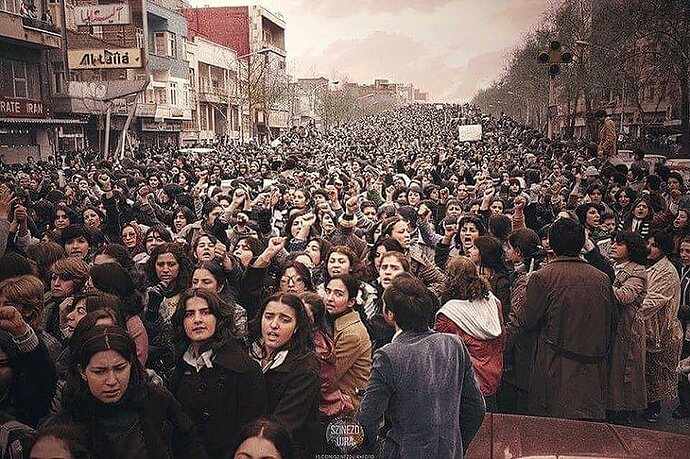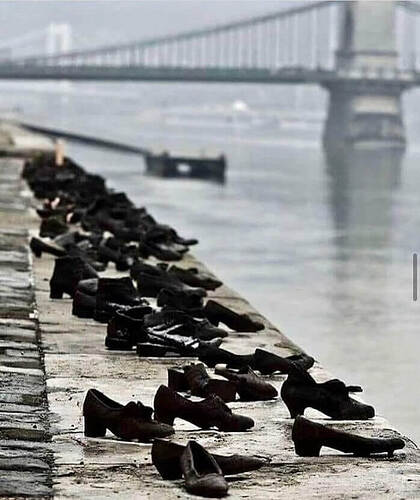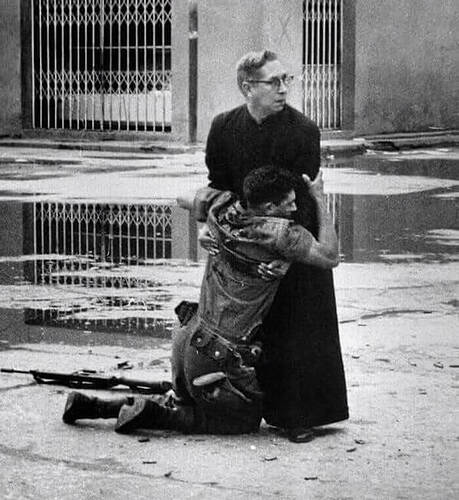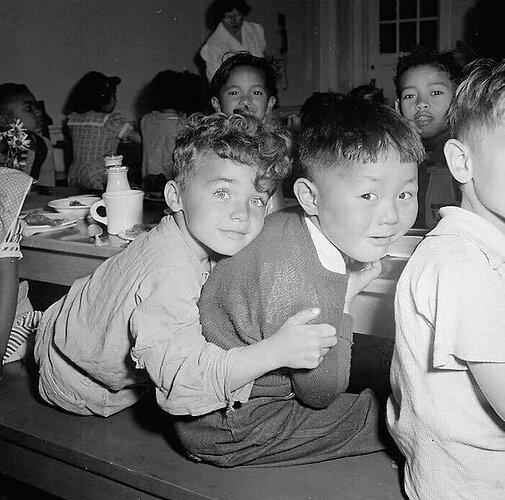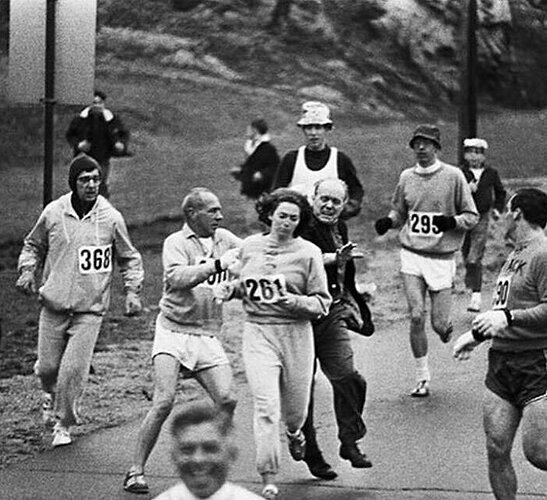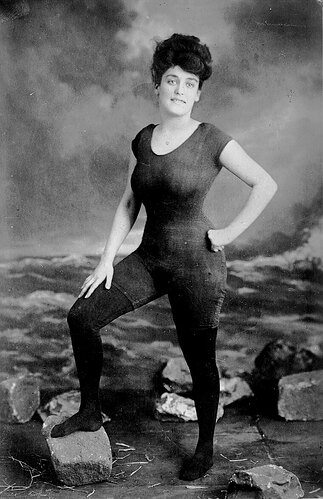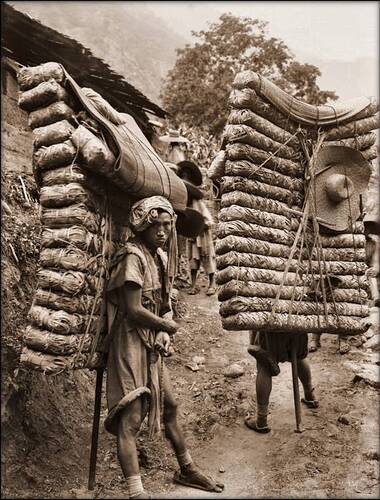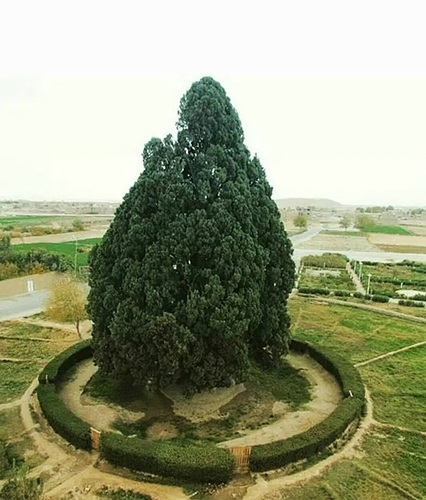.
First Woman to the Moon
Margaret Hamilton, featured in this rare historical photo from 1969, is the software engineer that history forgot to make into a household name, like Neil Armstrong or Buzz Aldrin. Hamilton led the NASA software team that landed the Apollo astronauts on the moon. She was a ‘software engineer’ before anybody even knew of the term, and in the photo featured, is standing next to what is believed to be the code or program listings for the successful Apollo space mission.
“She was a pioneer when it came to development of software engineering and…a pioneer as a woman in the workplace contributing to this type of program, taking on this type of role.” - said Dr. Teasel Muir-Harmony, the curator of the Project Apollo collection at the Smithsonian National Air and Space Museum.
Bringing Our Boys Home
This unbelievable photo is of the RMS Queen Elizabeth ship pulling into New York harbor in 1945, packed with US soldiers returning from Europe. The ship left Scotland on August 6th, 1945, and arrived in New York on August 11th, 1945. The ship looks absolutely packed which might be attributed to all of the soldiers coming up top for the arrival into NY, or it might be because Eisenhower opted to get more soldiers home all at once, rather than more ships with fewer soldiers on.
The original was taken in black and white, although it’s not clear how or from where the birdseye view photograph was captured. This color version of the photo is credited to Royston Leonard.
Iranian Women Protest Against The Hijab Law
Iran has had a history of forcing various laws on women that call Iran home. Though this photo is of a protest in Tehran in 1979, things haven’t changed very much. Even to this day, in 2022, the same demonstrations are happening around the country. However, Iran wasn’t always like this. There was a time when it was a modern world, and women could go to college, work, and not wear a hijab if they chose not to.
Though considering the same protests are happening over forty years later, all the Iranian citizens can do is hope and pray for things to change eventually.
The Ways We Remember
Seen here are sixty pairs of iron shoes line the banks of the Danube river, a memorial to the Jews of Budapest, Hungary, who were murdered during WWII. When the nationalist-socialist political party Arrow Cross took power in 1944, they aligned themselves with the Antisemitic stance of Hitler’s Nazi party, and began deporting thousands of Jews to concentration camps. Within days of them taking power, 600 Jews were murdered - with many rounded up and shot on the banks of the Danube.
In total, over 100,000 Jews from Budapest perished during the Holocaust i.e. over 50% of the Jewish community was eradicated. The shoes stand as a monument to those who were murdered simply because of their religion.
At the Hour of Our Death
This moving, Pulitzer Prize-winning photo was taken by Héctor Rondón during a rebellion that took place over five days in 1962 in the South American country, Venezuela. In the photo, chaplain Luis María Padilla holds a wounded soldier who was seriously injured in the infamous El Porteñazo anti-government rebellion. He was among 700 people injured during the short-lived rebellion, which also left 400 people dead. The uprising was ultimately unsuccessful in overthrowing the government.
Rondon’s photo ‘Aid from the Padre’ won the 1962 World Press Photo of the Year, as well as the Pulitzer Prize for Photography in 1963.
To Vax - It Wasn’t a Question
Two boys, one virus. The child on the left - unvaccinated, and the child on the right - received the vaccine. Before the smallpox virus was eradicated thanks to vaccines, as many as 9 in 10 babies died after contracting it. Smallpox was a life-threatening disease that involved pus-filled blisters all over your body. Smallpox survivors were often left blinded and terribly scarred. Although her name is not widely known, smallpox was eventually eradicated thanks to Lady Mary Montagu.
The vaccine for smallpox began with the idea of inoculation, Mary Montagu, herself a smallpox survivor and the wife of the British ambassador in Constantinople, wrote of the Turkish methods of ‘variolation’ that she had seen. She had both of her children inoculated, and while eventually, the British medical establishment recognized that this method worked - they gave her absolutely no credit.
Lunch Hour
This photo of two sweet-looking children speaks to a dark and horrific period of American history. Following Japan’s surprise attack on Pearl Harbor in 1941 and suspecting an invasion, President Roosevelt ordered the internment of all Japanese Americans living on the West Coast, regardless of whether they were US citizens or not. This photo; entitled ‘Lunch Hour’, was taken by Dorothea Lange at the Raphael Weill School in San Francisco - she captured the children together moments before the Japanese American population of the school was evacuated from the neighborhood.
In all, over 112,000 Japanese Americans were forced out of their homes and transferred to internment camps - where some spent as long as three years, enduring dehumanizing conditions, and the loss of their homes, jobs, and lives.
An Electrifying Kiss
One can never know when those CPR skills will be needed! This incredible photo, entitled “Kiss of Life”, features two coworkers, Randall G. Champion and J.D. Thomspon, utility workers out performing maintenance on electricity lines in 1967. Champion accidentally brushed against a low voltage line and went unconscious. His harness kept him from falling off the pole, while his quick-thinking coworker below him climbed up and gave him mouth-to-mouth. It was the photographer, Rocco Marabito who had been driving past, who called for an ambulance!
Thompson saved Champion’s life that day, and Rocco Morabito won the Pulitzer Prize for Spot News Photography for “The Kiss of Life” in 1968.
Running for Her Life
Kathrine Switzer had been training as a runner with men from her college’s cross-country team when they decided to run the Boston marathon together in 1967, when women were banned from participating in the 26 mile run. Switzer signed up and all went smoothly until a few miles into the race, when an organizer - furious that she was running - physically accosted her, trying to pull her number off and force her to drop out. Switzer completed the full marathon and went on to become an activist for women in sport.
Five years later, women were officially permitted to enter the Boston marathon. “I knew if I quit, nobody would ever believe that women had the capability to run 26-plus miles. If I quit, everybody would say it was a publicity stunt. If I quit, it would set women’s sports back, way back, instead of forward.” - Kathrine Switzer
Annette Kellerman Wore a Fitted Bathing Suit and Was Arrested for Indecency
Fortunately, most modern countries have come a long way since, but there was once a time when what this woman wore put her in prison. Her name is Annette Kellerman, and she was an Australian professional swimmer. However, she became infamous for her custom tight-fitted one-piece swimsuit. Around 1907 when she wore this, it was considered so scandalous she was arrested, and people were shocked at the controversy she stirred up.
Despite holding world records for swimming during that time, people of the 1900s were not ready to see her elbows and considered it distasteful and crude.
Starving in Uganda
In the photo, a Catholic missionary holds the hand of a starving Ugandan child thought to be around four years old. 60% of children in the Karamoja region of Uganda died during the famine of 1980. Although Mike Wells won the World Press Photo of the Year award for the photo, he says he’s ashamed that he took it, and that a newspaper sat on it for five months without publishing it - eventually only submitting it for the award.
Food shortages in the Karamoja region of Uganda began around 1980 when the region was at war with all of its neighboring countries. A complete lack of food and supplies brought on the famine, one of the worst in history.
Mommy’s Home
Yes, we’re also reaching for the tissues. This heart-wrenching photo of Major Terri Gurrola and her daughter Gaby became famous during the early years of the war in Iraq. This beautiful moment of reunion between Gurrola, a military doctor, and her toddler, was caught at Atlanta airport in 2007. Gurrola was arriving home for a two-week break from a seven month stint in Iraq, where she ended up being stationed for two years.
“Even now, looking at the picture brings tears to my eyes. It shows the true emotion of what we military parents go through.” - Gurrola, 2014
The Serial Killer’s 175-Year-Old Head In A Jar
Considered by many to be Portugal’s first serial killer, Diogo Alves was born in Galicia in 1810 and traveled to Lisbon as a young child to work as a servant in the affluent homes of the capital city.
It wasn’t long before young Alves realized that a life of crime was better for turning a profit, and in 1836, he had himself transferred to work in a home located on the Aqueduto das Águas Livres.
Despite the fact that those traveling across the Aqueduct were humble farmers returning home, Alves would lie in wait for them at nightfall, when he would rob them of their earnings.
Afterward, Alves would throw them over the edge of the 213-foot tall structure, sending them falling to their deaths. Between 1836 and 1839, he repeated this process some 70 times.
Local police initially attributed the deaths to copycat suicides, which led to a temporary closure of the bridge.
Alves then formed a group of bandits, before they were caught while killing four people inside the home of a local doctor, and Alves was arrested and sentenced to death by hanging.
But it’s what happened next that makes this one of history’s most interesting stories.
Scientists at the time wanted to study Alves’ head, to determine the origin of his murderous nature. For this reason, they had his head removed from his dead body and preserved in a jar for study — where it has remained ever since.
.
Peasant men carry bricks of tea on their back. The bricks of tea on their backs weigh more than 300 pounds. These men would often have to make deliveries by walking 112 miles on foot, with all of that weight on their backs,
Sichuan.
1908
.Flickr
Ralph Repo

Heavy air pollution, Tehran
The city suffers from severe air pollution, 80% of it due to cars. The remaining 20% is due to industrial pollution. Other estimates suggest that motorcycles alone account for 30% of air and 50% of noise pollution in Tehran. Tehran is also considered one of the strongest sources of greenhouse gas emissions in the Middle East. Enhanced concentration of carbon dioxide over the city (that are likely originated from the anthropogenic urban sources in the city) is easily detectable from satellite observations throughout the year.

The Tenere tree
It was the most isolated and the most lonely tree of the world
The nearest tree was 150 km away
It was an Acasia tree
It was knocked down in 1973 by a drunk truck driver.
The remain of the dead tree was moved to the Niger National Museum in the capital Niamey and they put a metal tree instead at its place.
Sarv-e Abarkuh
The oldest tree of Iran
.
The exact age of the tree has been difficult to determine, but it is estimated to be between 4000 and 5000 years old. Favorable natural conditions of its location have been credited as the main reason for the tree’s longevity.
.
There is a legend about the tree, which says the tree was first planted by Zoroaster. It is said that Zoroaster left to spread his teachings to an Iranian city towards Balkh and met Shah Vishtaspa. He stopped at Abarkuh and supposedly planted this tree.
.
It is a major tourist attraction with a height of 25 metres and with a perimeter of 11.5 metres
.
Stratosphere Giant
One of the tallest tree of the world will height more than one hundred meters.That’s about twice the size of the Statue of Liberty (minus the foundation).
It reigns as World’s Tallest Tree for four years
Three people in blue shirt are climbing the tree in the photo, and one in red shirt is standing at the ground.
Im not sure you can see them or not. I couldnt upload with more quality
.
The Dyerville Giant
The Dyerville Giant, a tree taller than the Statue of Liberty, fell to earth in 1991.
The Dyerville Giant was a 110-meter (362-foot) coast redwood tree (Sequoia sempervirens) in Humboldt Redwoods State Park, California, United States. The crash was so loud that people in the closest towns thought it was the noise of a big train accident. The redwood’s fall moved the earth so much that it registered on a nearby seismograph, a device scientists use to measure earthquakes.
Dave Stockton, who runs the Humboldt Redwoods Interpretive Association, remembers visiting the downed redwood the day after it fell. He walks alongside the tree past its base, where its unburied roots stick up from the ground like a giant antler, and points into the distance.
Stoclton explained he found pieces of the redwood tree 152 meters (500 feet) away on the other side of the highway.
The toppled Dyerville Giant is one of the many amazing trees that Stockton shows me while walking around the park one fall afternoon. Redwood trees are the tallest trees in the world, and the 21,448-hectare (53,000-acre) park is home to 130 trees that rise more than 107 meters (350 feet) into the air.
The park’s redwood trees are called coast redwoods, and their range stretches along the coast of California from Big Sur in the south to the Oregon state border in the north. There are two other types of redwood trees in the world: China’s dawn redwood (Metasequoia glyptostroboides) and California’s giant sequoia (Sequoiadendron giganteum), a shorter, wider tree located in the western Sierra Nevada Mountains. The tallest coast redwood is in Redwood National Park, nicknamed the Hyperion Tree. The previous record-holder was the Stratosphere Tree, found in Redwoods State Park.
Milkman made his delivers despite the flood in Buckinghamshire, England, 1954


